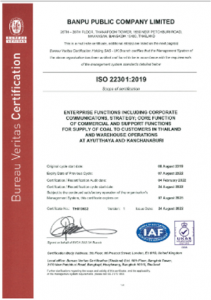
Business Continuity
Business Continuity Management

Significance & Commitment
The environment in which business is conducted could experience a disruption resulted from either natural or man-made threats. To minimize potential losses and maximize business resilience, the Company considers business continuity management as one of the key strategies.
Management Approach
The Company’s business continuity management system was developed based on the international standards such as ISO 22301:2012 and encompasses various processes including critical business function identification, business impact analysis, risk assessment, business continuity plan (BCP) development and BCP exercise. The crisis and emergency management teams have been established with classification into 4 levels: corporate level, country level, site level, and front-line level. Moreover, support teams such as Crisis Communication Team (CCT), Disaster Recovery Team (DRT), and Relative Response Team (RRT) have also been appointed.
The BCP exercises at each level are carried out regularly. For example, the head office in Thailand conducts the BCP exercise at the corporate and country levels on an alternate year basis. At country level, the Company performs an exercise at key business operations regularly with target to conduct an exercise at all business operations annually within 2025. In addition, the critical business function shall develop its BCP and exercise annually. The Company plans to broaden the exercise to cover more than 50% of critical business functions by 2025. The system performance is then reviewed annually by the Company through internal audits and management reviews.
Year in Review
The Company has been certified for ISO22301:2019 since 2022. This certification covers both the head office and related businesses in Thailand, as well as subsidiaries in China. In 2023, the Company carried out the annual BCP testing & exercising across various levels, with a focus on country-level at the head office in Thailand as well as subsidiaries in China, Australia and Japan.
The outcomes of 2023 exercises were in accordance with the set objectives whereby the IMT was promptly activated in response to the simulated incidents. Meanwhile, the business continuity plans for critical business functions were effectively implemented with recovery actions initiated within the pre-defined recovery time objectives. Throughout the exercises, incidents were communicated to stakeholders in a timely and appropriate manner.

